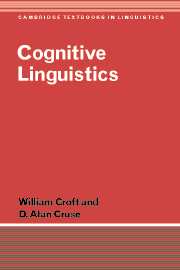Book contents
- Frontmatter
- Contents
- Figures
- Tables
- Preface
- 1 Introduction: what is cognitive linguistics?
- A conceptual approach to linguistic analysis
- Cognitive approaches to lexical semantics
- 5 Polysemy : the construal of sense boundaries
- 6 A dynamic construal approach to sense relations Ⅰ: hyponymy and meronymy
- 7 A dynamic construal approach to sense relations Ⅱ: antonymy and complementarity
- 8 Metaphor
- Cognitive approaches to grammatical form
- References
- Index
- Index
7 - A dynamic construal approach to sense relations Ⅱ: antonymy and complementarity
Published online by Cambridge University Press: 05 June 2012
- Frontmatter
- Contents
- Figures
- Tables
- Preface
- 1 Introduction: what is cognitive linguistics?
- A conceptual approach to linguistic analysis
- Cognitive approaches to lexical semantics
- 5 Polysemy : the construal of sense boundaries
- 6 A dynamic construal approach to sense relations Ⅰ: hyponymy and meronymy
- 7 A dynamic construal approach to sense relations Ⅱ: antonymy and complementarity
- 8 Metaphor
- Cognitive approaches to grammatical form
- References
- Index
- Index
Summary
Oppositeness
Aspects of the construal of oppositeness
The notion of oppositeness is well established in everyday language:
We were traveling in opposite directions.
I found myself sitting opposite the new Minister for Moral Regeneration.
John is tall and thin; Pete is just the opposite.
Mary is extrovert and makes friends easily; Jane is just the opposite.
He doesn't seem to be interested in the opposite sex.
There are undoubtedly different construals of opposite involved here, but intuitively they belong to a family. None of them are metalinguistic. But even speakers innocent of semantic theory have robust intuitions about lexical opposites, and even quite young children rapidly catch on to the idea. Like all sense relations, oppositeness is a matter of construal, and is subject to cognitive, conventional and contextual constraints.
There seem to be two main components in a construal of oppositeness. The first of these is binarity. Opposite meanings are construed as mutually exhausting some domain: within the appropriate domain, there are only two possibilities. Some domains are difficult to construe in any other way. For instance, there are only two directions along a linear path, so up and down, and forwards and backwards are natural opposites; likewise, there are only two extreme points on an axis, so top and bottom, and front and back are also natural opposites.
Information
- Type
- Chapter
- Information
- Cognitive Linguistics , pp. 164 - 192Publisher: Cambridge University PressPrint publication year: 2004
